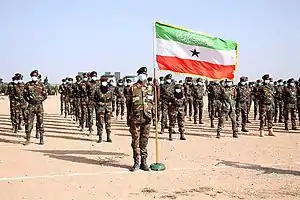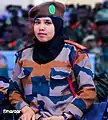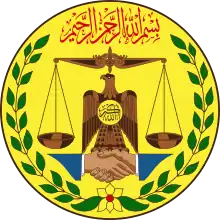| Somaliland National Army | |
|---|---|
| Ciidanka Qaranka Somaliland الجيش صوماليلاندي | |
 Members of the Somaliland National Army | |
| Founded | 1993 |
| Country | |
| Allegiance | Constitution of Somaliland |
| Type | Army |
| Role | Land warfare |
| Size | 29,000 est. [1]
Military age: 18 fd |
| Part of | |
| Garrison/HQ | Hargeisa, Somaliland |
| Motto(s) | "Allaa Mahad Leh, شكرا للاله” |
| Colors | Green, Red, White |
| Anniversaries | February 27th[2] |
| Engagements | Somaliland War of Independence Puntland–Somaliland dispute Battle of Las Anod 2010 Ayn clashes Battle of Tukaraq |
| Commanders | |
| President of Somaliland | Muse Bihi Abdi |
| Minister of Defense | Abdiqani Mohamoud Aateye |
| Commander | |
| Insignia | |
| Flag |  |
| Emblem |  |
| Beret and cap badge |  |
| Patch | |
The Somaliland National Army (Somali: Ciidanka Qaranka Somaliland, Arabic: الجيش صوماليلاندي), is the land force and largest branch of the Somaliland Armed Forces is based in the Somaliland capital of Hargeisa. There are approximately under 100,000 active members.[3] The Somaliland National Army is composed entirely of professionals and volunteers due to the army not being mandatory of conscription. Some Somaliland battalions operate near the Puntland border due to a border dispute. [4][5][6]
History

The history of the Somaliland army dates back to the Protectorate era and was founded by the British Army as Somaliland Camel Corps in the 20th. In 1941 World War II Italy invaded British Somaliland. In December 1941 after the liberation of British Somaliland from Italy. Somaliland Scouts has dissolution of the Somaliland Camel Corps in 1942, which was formerly tasked with the defense of the protectorate.[7]
The Somaliland National Army was established in 1993 and was established by the Somaliland reconciliation.[8]
Structure
The Somaliland Army is governed by the Ministry of Defence, is headquartered in Hargeisa. The Somaliland Armed Forces' Chief of Staff's office is in Hargeisa. He is the Chief of Staff of the Army, as well as the Navy and Air Forces, although the latter two typically report to the Ministry of Defence.
The Army currently operates 5 Divisions across 2 military regions. Each Division is equipped with a mechanised brigade with 3 specifically equipped with artillery batteries.
Each Division consists of 3 light infantry brigades.
- Army Command HQ- Birjeex (Hargeisa)
- 31st Division (Qeybta 31aad)
 JSL 31st Infantry Brigade (Qeyta 31aad Ee Hargeisa)
JSL 31st Infantry Brigade (Qeyta 31aad Ee Hargeisa) JSL Specialised Infantry Battalion
JSL Specialised Infantry Battalion JSL Mechanized Brigade
JSL Mechanized Brigade JSL Commandos Regiment ( Ciidamada Kamaandowsta)
JSL Commandos Regiment ( Ciidamada Kamaandowsta) JSL Army Band
JSL Army Band JSL Tank Brigade
JSL Tank Brigade
- 12th Division (Qeybta 12aad) Burco
 JSL 12th Infantry Brigade (Qeyta 12aad Ee Burco)
JSL 12th Infantry Brigade (Qeyta 12aad Ee Burco) JSL Mechanized Battalion
JSL Mechanized Battalion JSL Field Artillery Corps (Xeerada Gaaska Ee Burco)
JSL Field Artillery Corps (Xeerada Gaaska Ee Burco)
- 3rd Division (Qeybta 3aad) Ceerigaabo
 JSL 3rd Infantry Brigade (Qeyta 3aad Ee Ceerigaabo)
JSL 3rd Infantry Brigade (Qeyta 3aad Ee Ceerigaabo) JSL Mechanized Battalion
JSL Mechanized Battalion JSL Commandos Regiment ( Ciidamada Kamaandowsta)
JSL Commandos Regiment ( Ciidamada Kamaandowsta)
- 7th Division (Qeybta 7aad) Laascaanood - Taliska Guud Ee Aaga Bari Goojacade
 JSL 7th Infantry Brigade (Qeyta 7aad Ee Laascaanood)
JSL 7th Infantry Brigade (Qeyta 7aad Ee Laascaanood) JSL Tank Brigade
JSL Tank Brigade JSL Commandos Regiment ( Ciidamada Kamaandowsta)
JSL Commandos Regiment ( Ciidamada Kamaandowsta) JSL Specialised Infantry Battalion
JSL Specialised Infantry Battalion JSL Field Artillery Corps (Xeerada Gaaska Ee Goojacade)
JSL Field Artillery Corps (Xeerada Gaaska Ee Goojacade)
- 19th Division (Qeybta 19aad) Goroyo Cawl
 JSL Specialised Infantry Battalion
JSL Specialised Infantry Battalion JSL Mechanized Battalion
JSL Mechanized Battalion
Vehicles, Equipment and Camouflage

- Main Battle Tank
 T-55A (1974-1976) (MBT) – 87 in service and 42+ in operational service
T-55A (1974-1976) (MBT) – 87 in service and 42+ in operational service T-54B (1974-1976) (MBT) – 40 in service and 31+ in operational service
T-54B (1974-1976) (MBT) – 40 in service and 31+ in operational service T-72B (MBT) – current numbers unknown
T-72B (MBT) – current numbers unknown
- Armoured Personnel Carriers
- Transport Vehicles
- Self-Propelled Artillery
 BM-21 Grad (Multiple Rocket Launcher – 122 mm) – estimated 100 in both regular service and operational service
BM-21 Grad (Multiple Rocket Launcher – 122 mm) – estimated 100 in both regular service and operational service Humvee (Multiple Rocket Launcher)
Humvee (Multiple Rocket Launcher)
- Towed Artillery
- Mortar
- Anti-Aircraft Gun
- Camo
 U.S. Woodland (Primary Camo)
U.S. Woodland (Primary Camo) Multi-Terrain Pattern
Multi-Terrain Pattern
| Weapon | Origin | Notes | ||
|---|---|---|---|---|
| Assault Rifle | ||||
| AK-47 | Soviet Union | Imported from Ethiopia and Yemen | ||
| AKM | Soviet Union | Imported from Ethiopia and Yemen | ||
| AK-74 | Soviet Union | Imported from Ethiopia and Yemen | ||
| AK-74M | Soviet Union | Somaliland modernised version of the AK | ||
| AK-103 | Russia | Imported from Ethiopia | ||
| FN FAL | Belgium | Current origins of this weapon is unknown | ||
| M16A1 | United States | Current origins of this weapon is unknown | ||
| Sidearm | ||||
| Skorpion vz. 61 | Czechoslovak | Seized after the Somaliland War of Independence | ||
| TT Pistol | Soviet Union | Seized after the Somaliland War of Independence | ||
| Sniper Rifle | ||||
| Dragunov Sniper Rifle | Soviet Union | Seized after the Somaliland War of Independence | ||
| Barrett M82 | United States | Spotted in the may 18th 2023 independence parade | ||
| Machine Gun | ||||
| PK | Soviet Union | Seized after the Somaliland War of Independence | ||
| DShK | Soviet Union | Seized after the Somaliland War of Independence | ||
| NSV | Soviet Union | Seized after the Somaliland War of Independence | ||
| RPK-74 | Soviet Union | Seized after the Somaliland War of Independence | ||
| Anti Tank Weapons | ||||
| RPG-7 | Soviet Union | Seized after the Somaliland War of Independence | ||
| Drill Purpose Rifles | ||||
| SKS | Soviet Union | Seized after the Somaliland War of Independence | ||
Ranks
| Rank group | General / flag officers | Senior officers | Junior officers | Officer cadet | ||||||||||||||||||||||||||||||||
|---|---|---|---|---|---|---|---|---|---|---|---|---|---|---|---|---|---|---|---|---|---|---|---|---|---|---|---|---|---|---|---|---|---|---|---|---|
 |
 |
 |
 |
 |
 |
 |
 |
 |
||||||||||||||||||||||||||||
| Lieutenant general Sareeye Guud |
Major general Sareeye Gaas |
Brigadier general Sareeye Guuto |
Colonel Gashaanle Sare |
Lieutenant colonel Gashaanle Dhexe |
Major Gashaanle |
Captain Dhamme |
First lieutenant Laba Xídígle |
Second lieutenant Xídígle |
||||||||||||||||||||||||||||
| Rank group | Senior NCOs | Junior NCOs | Enlisted | |||||||||||||||||||||||||||||||||
|---|---|---|---|---|---|---|---|---|---|---|---|---|---|---|---|---|---|---|---|---|---|---|---|---|---|---|---|---|---|---|---|---|---|---|---|---|
 |
 |
 |
 |
 |
 |
 |
 | |||||||||||||||||||||||||||||
| Chief warrant officer Musharax sarkaal |
Warrant officer class 1 Sadex xarígle |
Warrant officer class 2 Laba xarígle |
Warrant officer class 3 Xarígle |
Sergeant Sadex alífle |
Corporal Laba alífle |
Lance corporal Alífle |
Private (or equivalent) Dable | |||||||||||||||||||||||||||||
Gallery
 Women in Somaliland Army
Women in Somaliland Army Somaliland Army in Independence Day Parade.
Somaliland Army in Independence Day Parade. Training women of the Somaliland Army.
Training women of the Somaliland Army. Somaliland Technical.
Somaliland Technical. Somaliland BM-21 Grad
Somaliland BM-21 Grad
Combat History
Somaliland War of Independence
The Somaliland War of Independence (Somali: Dagaalkii Xoraynta Soomaaliland, lit. 'Somaliland Liberation War') was a rebellion waged by the Somali National Movement against the ruling military junta in Somalia led by General Siad Barre lasting from its founding on 6 April 1981 and ended on 18 May 1991 when the SNM declared what was then northern Somalia independent as the Republic of Somaliland. The conflict served as the main theatre of the larger Somali Rebellion that started in 1978. The conflict was in response to the harsh policies enacted by the Barre regime against the main clan family in Somaliland, the Isaaq, including a declaration of economic warfare on the Isaaq. These harsh policies were put into effect shortly after the conclusion of the disastrous Ogaden war in 1978.
During the ongoing conflict between the forces of the Somali National Movement and the Somali Army, the Somali government's genocidal campaign against the Isaaq took place between May 1988 and March 1989, with explicit aims of handling the "Isaaq problem", Barre ordered the shelling and aerial bombardment of the major cities in the northwest and the systematic destruction of Isaaq dwellings, settlements and water points.[31] The Siad Barre regime targeted civilian members of the Isaaq group specifically, especially in the cities of Hargeisa and Burao and to that end employed the use of indiscriminate artillery shelling and aerial bombardment against civilian populations belonging to the Isaaq clan.
Puntland–Somaliland dispute
The Puntland–Somaliland dispute is a territorial dispute over the provinces of Sool, Sanaag and the Buuhoodle district of Togdheer region between the self-declared Republic of Somaliland and the Puntland state of Somalia. The territory was historically part of British Somaliland, a British protectorate that granted independence in 1960 and then formed a union with neighboring Italian colony Trust Territory of Somaliland to form the Somali Republic. When the Somaliland War of Independence was concluded and the Somali Civil War broke out, Somaliland declared independence from Somalia in 1991 as a successor state to the British protectorate and declared independence from Somalia.
The dispute started in 1998, when Puntland was formed as an autonomous state of Somalia and declared the region as part of its territory based on tribal affiliation of the locals.
Battle of Las Anod
The Battle of Las Anod saw Somaliland forces engage Puntland forces in Las Anod, capital of the Sool region. The ensuing battle resulted in Somaliland ousting the Puntland army from the city. Las Anod had until then been controlled by Puntland, who took control of the regional capital in 2002.
Somaliland had however been aiding local clan militias opposed to Puntland presence in the city. The clan militias were loyal to Ahmed Abdi Habsade, a former Puntland minister who later on defected to Somaliland. In October 2007, the conflict mushroomed into a regional conflict over control of the city of Las Anod, as Somaliland regular army forces mobilized from their base in the town of Adhicadeeye, west of the city, and entered the conflict. Puntland was slow to mobilize a counter-attack, as Puntland's weak economy and overstretched military obligations in Mogadishu prevented a rapid response. After assuming control of the city on October 15, Somaliland moved Sool's regional administration into Las Anod. Between 10 and 20 people were reported to be dead.
2010 Ayn clashes
The 2010 Ayn clashes saw Somaliland forces engage Dulbahante clan militia in the Buuhoodle district. The battle was prompted by Ethiopian troops seizing a truck belonging to locals in Buuhoodle, sparking a response from residents and Ethiopian retaliatory attack on Buuhoodle and a Somaliland attack upon Widhwidh. More clashes were reported to have occurred near Widhwidh on 19 July 2010.
Battle of Tukaraq (2018)
In 2018, the Battle of Tukaraq saw Somaliland forces engage Puntland forces in Tukaraq, a town in the eastern Sool region, on the road between the regional capitals of Las Anod and Garowe. The ensuing heavy clashes resulted in Somaliland ousting the Puntland army from the town. The battle was significant as it was the first time both forces clashed directly.
Las Anod Conflict (2023)
The 2023 Las Anod conflict is an ongoing armed conflict between the Somaliland National Army and the militia forces of the Dhulbahante in Las Anod, the capital of the Sool region.[9] Fighting erupted on February 6 after Somaliland security forces held a crackdown on civil protests.
See also
References
- Citations
- ↑ http://indepthafrica.com/somaliland-after-two-decades-the-armed-forces-come-to-age/#.URr3NqWpN8w
- ↑ "Xuska Sannad-Guurada 27aad Ee Aas-Aaska Ciidanka Qaranka Jamhuuriyadda Somaliland". Government of Somaliland.
- ↑ Horton, Micheal (November 2019). "How Somaliland Combats al-Shabaab". CTC Sentinel. 12 (10): 24. Archived from the original on 27 March 2022. Retrieved 15 May 2023.
- ↑ "UK seeking working relationship with Somaliland on military matters". 28 January 2020.
- ↑ "Ciidanka Somaliland oo xirtay darajo - BBC Somali - Warar". www.bbc.com.
- ↑ "Ciidanka Somaliland oo maanta dhaqdhaqaaqyo ka wada gobolka Cayn. - Mustaqbal Radio".
- ↑ "Wax ka baro taariikhda ciidanka qaranka somaliland. | ToggaHerer".
- ↑ ""Ma seexdayaasha Aynu Ku seexano" Taariikhda Ciidanka Qaranka Somaliland". 18 July 2018.
- ↑ "What's driving conflict in the disputed Somali city of Las Anod?". www.aljazeera.com. Retrieved 2023-07-05.
External links
